Tradition
About Andrew Cusack
 Writer, web designer, etc.; born in New York; educated in Argentina, Scotland, and South Africa; now based in London.
Writer, web designer, etc.; born in New York; educated in Argentina, Scotland, and South Africa; now based in London. read more
News
Blogs
Reviews & Periodicals
Arts & Design
World
France
Mitteleuropa
Knickerbockers
Argentina
The Levant
Africa
Cape of Good Hope
Netherlands
Scandinavia
Québec
India
Muscovy
Germany
Academica
O.C.H., R.I.P.
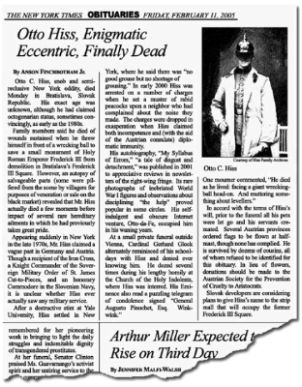
Alas, one of my favorite blogs has come to an end.
Candlemas
Down with the bays and misletoe
Down with the holly, ivy, all,
Wherewith ye dress’d the Christmas Hall
That so the superstitious find
No one least branch there left behind
For look, how many leaves there be
Neglected, there (maids, trust to me)
So many goblins you shall see.
Today, February 2, is Candlemas Day: the Feast of the Presentation of Jesus in the Temple. This is the day, forty days after the Nativity, when Mary brought Jesus to the Temple to offer a sacrifice for her purification after giving birth to a boy, as prescribed by the Mosaic law.
And behold there was a man in Jerusalem named Simeon: and this man was just and devout, waiting for the consolation of Israel. And the Holy Ghost was in him.
And he had received an answer from the Holy Ghost, that he should not see death before he had seen the Christ of the Lord.
And he came by the Spirit into the temple.
And when his parents brought in the child Jesus, to do for him according to the custom of the law, He also took him into his arms and blessed God and said
Now thou dost dismiss thy servant, O Lord, according to thy word in peace:
Because my eyes have seen thy salvation,
Which thou hast prepared before the face of all peoples:
A light to the revelation of the Gentiles and the glory of thy people
Israel.
And his father and mother were wondering at those things which were spoken concerning him.
And Simeon blessed them and said to Mary his mother:
Behold this child is set for the fall and for the resurrection of many in Israel and for a sign which shall be contradicted.
And thy own soul a sword shall pierce, that, out of many hearts
thoughts may be revealed.
And there was one Anna, a prophetess, the daughter of Phanuel, of the tribe of Aser. She was far advanced in years and had lived with
her husband seven years from her virginity.
And she was a widow until fourscore and four years: who departed not from the temple, by fastings and prayers serving night and day.
Now she, at the same hour, coming in, confessed to the Lord: and
spoke of him to all that looked for the redemption of Israel.
And after they had performed all things according to the law of the Lord, they returned into Galilee, to their city Nazareth.
The feast is often called Candlemas because it is the day which candles of beeswax are blessed, while reciting the antiphon ‘Lumen ad revelationem gentium et gloriam plebis tuæ Israel’ from the canticle of Simeon cited above.
In Scotland, the Protestant revolution did away with all that, but Candlemas remained as a legal quarter day. At St Andrews, the second semester is Candlemas term. There used to be trimesters, consisting of Martinmas, Candlemas, and Whitsun terms, but the semester system was introduced during the 1990’s and Whitsun term faced the axe. Some folks at St Andrews, however, refer to the part of the second semester after the two-week Easter holiday as Whitsun or Whitsunday term.
In America, the day evolved into Groundhog Day, the earliest recording of which dates from the diary of Pennsylvania storekeeper in 1841:
UPDATE: Dr. Curmudgeon & Co. have a good Candlemas post.
Candlemas:
Catholic Encyclopaedia
Wikipedia
Groundhog Day:
Wikipedia
About Time
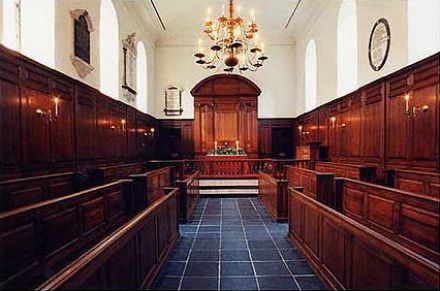
The Chicago Tribune reports that three of Virginia’s best public universities are seeking to privatise. I’ve often thought that it’s about time the College of William & Mary returned to the private sector. If only because it would allow them to keep a cross in their beautiful Wren-designed chapel full time (see above). But of course, given the state of academia today, that’s unlikely anyhow. W&M only became public around 1912 if my memory serves me well. Similar proposals have been aired in South Carolina, especially in regards to the more prestigious of its public colleges, the College of Charleston (f. 1770), and the Citadel, the Military College of South Carolina.
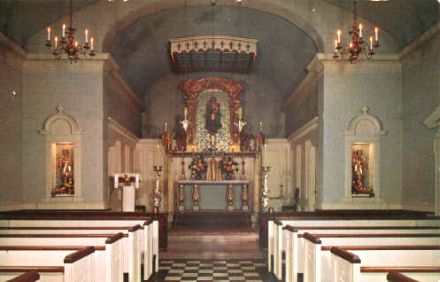
Williamsburg is also home to St. Bede’s Church, which was once also the American Shrine of Our Lady of Walsingham. The parish is now the largest “faith community” in Williamsburg, but seems to have faltered in its devotion to Our Lady. Due to its increasing size, a dodgy new round church is being built.
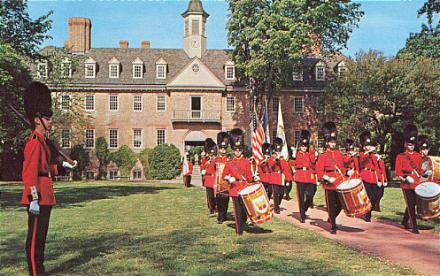
The officers-in-training from the College of William and Mary form the Queen’s Guard, named so in recognition of the honors bestowed upon the College by Queen Mary II, Queen Anne, and Queen Elizabeth II.
Warner on the Gotha
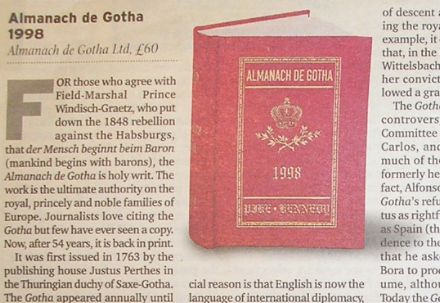
Whilst rummaging through my room at home in New York last week, I came across this article which I had cut out of the ill-fated European in 1998 written by none other than Mr. Gerald Warner, KM. I was fourteen years old in 1998 and the European folded about a year later. Click here to read in jpg form. (A large file, some browsers may require resizing to view the text at a readable size).
The Oldest Library in New York
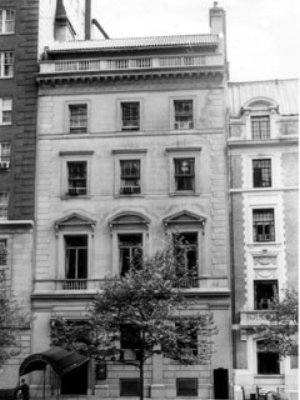
When one thinks New York and thinks libraries, the obvious place which comes to mind is the New York Public Library, one of the largest libraries in the world with one of the most beautiful homes in Bryant Park on 42nd St. 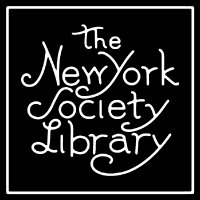 The Public Library was formed in the mid-19th century by a merger of the private Astor, Lennox, and Linden libraries. The great metropolis, however, is home to a much older bibliotheca called the New York Society Library, founded in 1754.
The Public Library was formed in the mid-19th century by a merger of the private Astor, Lennox, and Linden libraries. The great metropolis, however, is home to a much older bibliotheca called the New York Society Library, founded in 1754.
In that year, six ‘civic-minded individuals’ formed the New York Society with the aim of founding a library which would be “very useful as well as ornamental to the city”. The ‘city library’ was given a room in the old City Hall (later, as Federal Hall, home to the United States Congress), and received a charter from H.M. King George III in 1772. Unfortunately the Library was looted during the Revolution, but survived and was restocked afterwards, receiving a second charter from the Assembly of the State of New York.
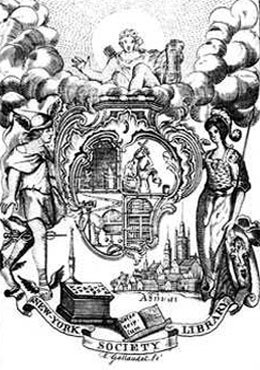
The Society Library is still, as it was then, a subscription library which operates almost like a private club, though open to all who will subscribe (and the Society Library’s membership fee is much more economical than a club). The N.Y.S.L. merged with the New York Athenaeum in 1840, and having been located a various locations around lower and mid Manhattan, in July 1937 moved its collection of one hundred and fifty thousand volumes into 53 East 79th Street (seen at top), where it continues today.
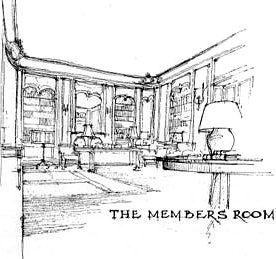
I’ve never been to the Library myself, though it seems a suitably comfortable and private location to read or research, and not expensive to boot. Perhaps I will strike up a subscription when I am next in New York as a full-time resident. They even have a Children’s Room which would be useful when progeny appear.
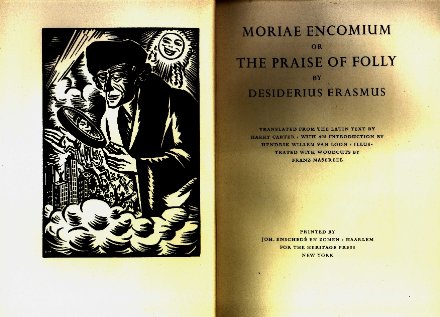
A Good Point
John Lukacs, in his A Student’s Guide to the Study of History, says in a footnote:
This is my essential point about architecture today. If one looks at the actual built quality of buildings by Duncan Stroik or Thomas Gordon Smith, one may appreciate the overall idea or effort but frown upon the execution, call it clumsy or whatnot. The point is that though these people may or may not be masters themselves, they are raising a new generation of architects who are in tune with the past and thus able to more readily plot a future of beauty and mastery. With any luck, within 50-100 years, architecture will have recovered from the uninspiring malaise in which it currently dwells.
The Remarkable Hapsburgs

Last night, Fr. Emerson popped up from Edinburgh and gave a talk on the Hapsburg dynasty. It was tremendously interesting. I learned so much I hadn’t known before and it opened up a terrific number of avenues of information down which I have only begun to stroll.
I had no idea how remarkable a man Franz Ferdinand was. All they teach you in America is “This is the guy who got shot” instead of “This man would have been the savior of all that is good and holy in Europe.”
I have seen and read a lot of what Europe is today; Fr. Emerson gave us a glimpse of what Europe was yesterday, before the utter destruction of the social order of the continent by that moment in Sarajevo and everything that came after it. Knowing what Europe was, how depressing to see it now!
It also filled me with some optimism, oddly enough. I used to be partly in the school of thought that’s convinced that Europe is lost. If this is how Europe was, surely it could be again? Perhaps, perhaps not. (more…)
Next Wednesday
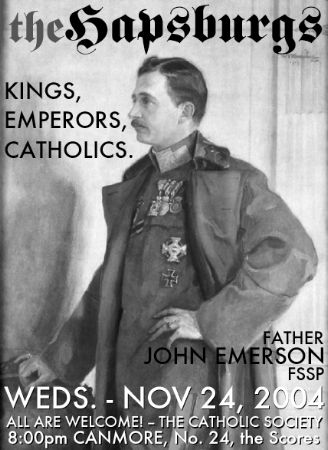
Fr. Emerson will be returning to to Canmore next week to give a talk on the Hapsburgs.
The Ark and the Dove
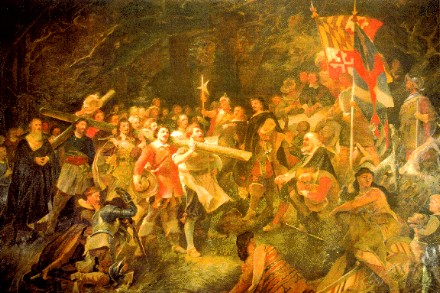
Yesterday, whilst plotting reaction deep within the Cellar Bar on Bell St, the subject of the Catholic landing in Maryland came up. The event took place on March 25, 1634, when the passengers of the Ark and the Dove disembarked upon the shores of Terra Mariae, held a Mass, and then hewed a Cross out of felled trees, raising it while saying the Litany of the Holy Cross.
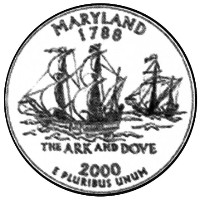 Surely these three elements of Angledom, Catholicism, and America make March 25 a festival of the apex of civilization?
Surely these three elements of Angledom, Catholicism, and America make March 25 a festival of the apex of civilization?
The Ark and the Dove were the subject of a rejected proposal for the Maryland state quarter.
Anyhow, descendants of the passengers of the Ark and the Dove might be interested in joining the Society of the Ark and the Dove, the insiginia of which can be seen below. (Image courtesy of the Hereditary Society Community).
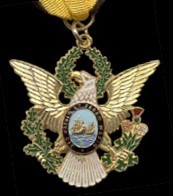
NYU Students Take to the Streets…
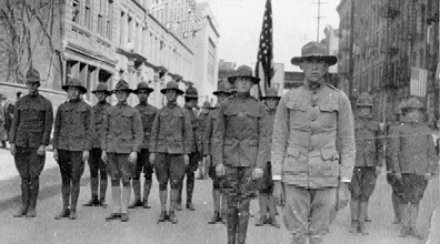
…to join in the fight against our cousins, the Hun. I doubt many of NYU’s ROTC students would be brave enough to don their BDUs in the streets of Greenwich Village these days. Well I don’t doubt they’d be brave enough, but they’d no doubt be more prudent perhaps. Anyhow, the ROTC program for all the colleges and universities in the City are based up in the Bronx at fortress Fordham, where the administration has been happy to play host to the future leaders of America. (Though we’ve heard the Pershing Rifles at Fordham are given to somewhat riotous behavior). This li’l bit of New York nostalgia was dug up from the NYU Archives.
Knickerbocker
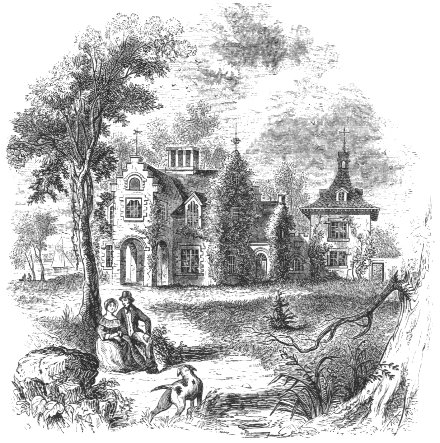
Perhaps you should join me in reading A history of New York, from the beginning of the world to the end of the Dutch Dynasty by Diedrich Knickerbocker, Washington Irving’s superb masterpiece of New York mythology. Above is an old rendering of Sunnyside, Washington Irving’s home in Tarrytown.
I’m in the midst of Book II, the more interesting part. However, reading books online is rather irritating, and a strain on the old eyes, so I might give in sometime soon and get Ottakar’s to order it in. (Actually, I might be able to get a nifty ‘thift edition’ on Amazon.co.uk). Sadly, Ottakar’s don’t believe in stocking the classics of New York literature. And so we must mourn for them.
St Andreans were all quite intrigued by the arrival of an Ottakar’s branch, but it’s turned out to be all in vain. Though it is bigger than any other bookshop in town, that’s not saying much, and the rumours that it would be two floors have turned out to be woefully untrue. Give me the Strand and it’s eighteen miles of books (used to be just eight miles) any day of the week.
Chain bookstores are atrocious anyhow and are best avoided when it comes to purchasing. Whenever I feel like book browsing in Westchester, if I don’t feel satisfied by the Womrath Bookshop on Pondfield Rd in Bronxville then I will browse Border’s on White Plains Road in Eastchester (or Scarsdale, as it claims), find something interesting, and order it from Womrath’s. The Strand is the best because it gives you 1) the varied selection usually only available at massive chain stores, 2) the quality of service of independent bookshops, and 3) the added bonus of used books, which are quite often better editions than more recent reissues. Eighteen miles of books, people! That’s insane.

Thierry d’Argenlieu
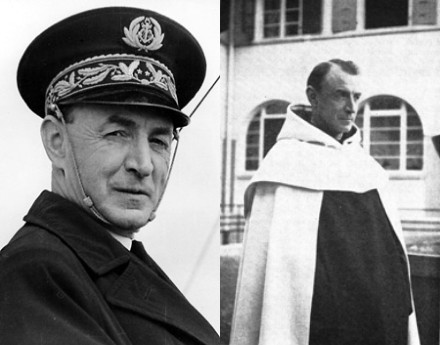
Today we bring you the story of a man known as both Brother Louis of the Trinity, OCD, and Admiral Georges Thierry d’Argenlieu.
D’Argenlieu graduated from the Ecole Navale in Brest and was awarded the Legion d’Honneur for his actions in the Great War. After the war, he became a Carmelite friar, taking the name of Louis de la Trinité. As the Second World War commenced, he once again put on the uniform and partook in the defence of France from the pagan Nazis. Once France was vanquished, he escaped to London where he allied himself with General de Gaulle and the Free French Forces, eventually becoming the commander of the Free French Naval Forces. At the Liberation of the Paris, he strode down the Champs Elysée with de Gaulle and Leclerc and attended the Te Deum at Notre-Dame.
Incidentally, he was also the one who suggested the adoption of the Croix de Lorraine as the symbol to differentiate the Free French Forces from those of Vichy France.
In 1947 however, while Governor-General of Indochina, his request to leave the Armed Forces was granted, and he returned to life as a Carmelite, dying at the Priory of Avon in 1964.
More about Admiral d’Argenlieu/Father Louis here, here, and here.
Blessing the Hounds in Virginia
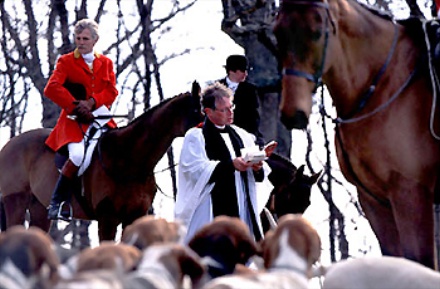
Photo: National Geographic
The Other September 11th
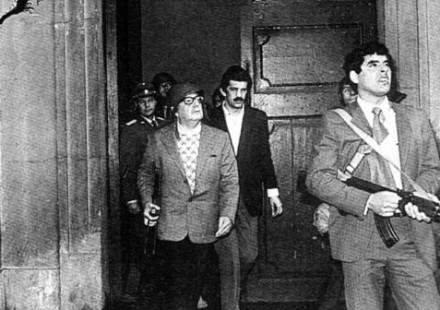
¡No Pasaran! has a post on Chile’s would-be dictator, Salvador Allende (seen above, helmeted, in the last photo taken of him alive). Many left-wing urban intellectuals both in the Americas and Europe fawn over Allende as the heroic democratically-elected savior of the proletariat who was cruelly overthrown by the reactionary military just moments before a Socialist paradise would have been achieved. Nothing could be further from the truth.
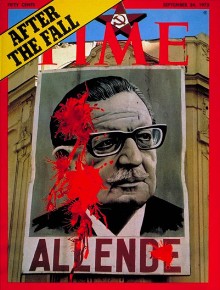
Higher Learning
Via Mere Comments.
A hand shot up. “Mr. Letendre, how do we learn from our mistakes?”
I went up to her and said, “Hold out your hand.” She did and I slapped it smartly.
“Hold out your hand,” I said again.
“No!” she replied.
“Congratulations!” I said. “You have just learned from your mistake.” I turned to another student. “Hold out your hand.”
“No!” he replied.
“See, you learned from her mistake. The only way we humans learn is by making mistakes. Thomas Edison made 1,000 mistakes before he invented the light bulb. It’s better to learn from other people’s mistakes. Do you know what we call learning from other people’s mistakes?”
“No,” the class answered.
“We call it History!” I proclaimed.
Another year of teaching had begun.
Straw Boaters
 The other evening whilst out on the town with Will Moller (Groton ’02, Kenyon ’06), I was pleased to learn that Groton still graduates its male student in straw boaters.
The other evening whilst out on the town with Will Moller (Groton ’02, Kenyon ’06), I was pleased to learn that Groton still graduates its male student in straw boaters.
I think straw boaters are about due for a revival. And not those horrific plastic numbers that proliferate around convention and campaign time. The real deal. The trouble is the best place to start a straw boater revival is St Andrews, and we’re only all in St Andrews when straw boaters aren’t really “in season” as the sartorialists would say.
A Saint Returns Home
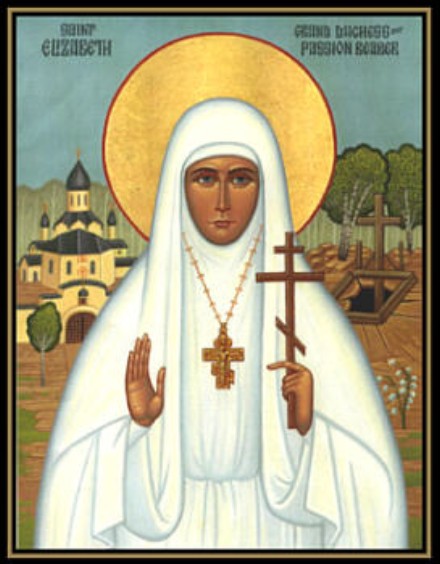
Relics of Saint Elizabeth Romanoff have been greeted enthusiastically by Muscovite crowds, according to Russia’s state-run ITAR-TASS news agency.
To discover the beautiful witness to Christ of Saint Elizabeth, read more about her at the Orthodox Christian Information Center and on the site of Fr. Demetrios Serfes. A statue of the holy Grand Duchess now graces the front of Westminster Abbey.
Who’s still afraid of Keith Windschuttle?
Published in

By Ean Higgins
July 22, 2004
AS the elite of the nation’s academic historians met in the stately rooms of the Newcastle Town Hall, fear and loathing lurked the corridors.
The Australian Historical Association spent virtually an entire day trying to work out strategies to deal with the menace. Would there be safety in numbers if academics stood together? What should be done when the terror struck again? How could anyone survive when the mass media was in on the conspiracy?
Over 18 months after Keith Windschuttle published his book The Fabrication of Aboriginal History, the academic world is still anguishing over its impact. It is terrified of what he will do next. Windschuttle struck at the heart of the accepted view of Australian colonial history in the past 30 years – that the settler society had engaged in a pattern of conquest, dispossession and killing of the indigenous inhabitants. The facts, he said, did not stack up.
The Sydney-based writer, among other things, questioned the references used by academic historian Lyndall Ryan to justify her claims that the British massacred large numbers of Aborigines in Van Diemen’s Land in the early 1800s. Her footnotes supporting the claims did not do so, he wrote.
He also took on Henry Reynolds, the venerable historian of the Left, whose depiction of a brutal British conquest of Tasmania had been the accepted norm.
Reynolds’s work on the concept of terra nullius — that the British seized Aboriginal land based on a policy that it was owned by no one — developed such currency that it is believed to have influenced critical High Court judgments on land rights, including the Mabo decision. The thrust of Windschuttle’s thesis was that political correctness had triumphed over historical fact.
With the passage of time, the academic history profession is far from over the history wars. An extraordinary number in its ranks believe they have been been damaged by populist history propounded by Windschuttle. They are searching for a way out. Only a few seem brave enough to speak up, arguing that freedom of expression is the primary issue.
At the recent conference, Ryan made some effort, though ultimately unsuccessful, to avoid media coverage for a talk she gave entitled How the Print Media Marketed Keith Windschuttle’s The Fabrication of Aboriginal History: Implications for Academic Historians.
She said the media had taken up Windschuttle as representing the real history of colonists’ relations with Aborigines, grabbing the view that Australians had been hoodwinked by the academic left-wing historians’ version. “I don’t think the media owns free speech,” Ryan said. She had also been shocked, she said, that Stuart Macintyre, the influential left-leaning University of Melbourne historian, had appeared to criticise her over footnote inaccuracies.
She did admit to five footnote errors, but said the primary sources verified her thesis and “the simple fact is that footnote errors do occur”.
Her abstract said: “The AHA and universities need strategies and protocols in place to address future assaults on academic historians.”
Ryan was not alone in promoting the Windschuttle-media conspiracy. The AHA president, David Carment, said the The Australian had deliberately timed the publication of its review of Windschuttle’s work for the summer of 2002. During holidays more academics were on leave, Carment said, and “less able to defend themselves,” and it was “a time when people were reading newspapers”. (In fact, newspaper circulations fall away over summer holidays.)
It might be time, Carment said, for the association to “defend its people on the basis of their professional integrity” while not taking sides in the debate.
Carment also raised, though he did not fully support, the concept put forward by West Australian historian Cathie Clement for a code of ethics that would gag historians from criticising the integrity of their peers in public. Several in the audience said everyone had to be ready to counter-attack when Windschuttle came out with his next book.
Richard Waterhouse from the University of Sydney, said academics took Windschuttle too seriously. “Sometimes we have tended to treat him as an intellectual equal,” Waterhouse said, adding that sarcasm might be more appropriate. (Windschuttle earned a first-class honours degree in history from the University of Sydney in the 1960s, lectured in the subject, earned a masters in politics and left Macquarie University in 1992 when he set up a publishing house.)
There were a couple of muted mutterings from the audience about how it would be necessary to learn media skills, and not attempt to look like academics defending their own cabal. But nobody at the session publicly asked the key question which was in some of their minds: was the academic historians’ fear of Windschuttle and newspaper opinion pages absolutely paranoid?
Greg Melleuish, from the University of Wollongong, says he is intimidated by the pack mentality of the Newcastle meeting. “I was quite astonished,” he says. “It was like ‘let’s get a group of people together to ambush Windschuttle’. I think they feel under threat and that’s why they concoct these conspiracy theories.”
Other historians have expressed alarm at the attitude of their peers, including classical studies historian Ronald Ridley at the University of Melbourne. “The way they have shut down the debate, if they have made some errors, is really appalling,” he says.
“I don’t think any historians of Greek or Roman history would make these mistakes. And when you deal with issues such as indigenous history, the politics are red hot. You don’t just have to be a competent historian, you have to be top class.”
The question is why academic historians are so concerned about the impact of Windschuttle.
Macintyre, while he does not accept Windschuttle’s suggestion of a fabrication, does warn that mistakes can have a broader effect.
“There is an understandable public concern about the accuracy of historians’ work,” he says. At the same time, Macintyre maintains, Windschuttle fits with a conservative agenda to lift a burden of national shame from Australian shoulders over the Aboriginal issue.
Macintyre told the conference the history wars fitted in with broader “political dimensions” of the Howard Government’s “abandonment of reconciliation, denial of the stolen generations, its retreat from multiculturalism and creation of a refugee crisis”.
“Windschuttle was the first conservative intellectual to base his case on substantial historical research,” he says.
Windschuttle says this is precisely why the academic community is still so scared of him. “There is a whole generation who have invested not just their academic capital but also their political capital in the Henry Reynolds view,” he says. And, says Windschuttle, he has made Australian history interesting again for high school students who are more likely to go on to study it in universities.
While not referring to the Windschuttle debate, NSW Premier Bob Carr, a longstanding history buff, said much the same thing at the conference.
“History is an argument and the more argument there is in it the more young people will read it,” he said.
Long Live Our Holy Germany!
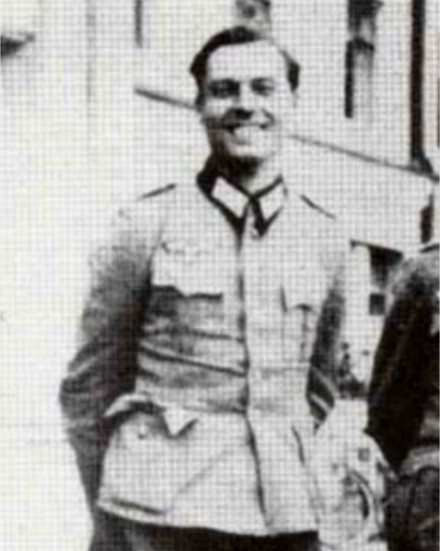
It was July 20, 1944, sixty years ago today, that Col. Claus Schenk Graf von Stauffenberg was executed for his masterminding the plot to kill Adolf Hitler. Stauffenberg was a devout Catholic who became convinced that Hitler was an Antichrist.
“Fate has offered us this opportunity, and I would not refuse it for anything in the world. I have examined myself before God and my conscience. It must be done because this man is evil personified.”
His uncle, Graf (Count) Nikolaus von Üxküll, recruited him into the resistance movement after the Polish campaign in 1939. After a series of missed opportunities, Stauffenberg finally placed a bomb to kill Hitler. Unfortunately, it was moved to the other side of a strong oak table supporter, shielding Hitler from the full force of the blast. Claus Philip Maria Shenck Graf von Stauffenberg was shot by the Gestapo at half past midnight that same evening.
His dying words were “Es lebe unser heiliges Deutschland!” – Long live our holy Germany.

Search
Instagram: @andcusack
Click here for my Instagram photos.Most Recent Posts
- Amsterdam November 26, 2024
- Silver Jubilee November 21, 2024
- Articles of Note: 11 November 2024 November 11, 2024
- Why do you read? November 5, 2024
- India November 4, 2024
Most Recent Comments
- on The Catholic Apostolic Church, Edinburgh
- on Articles of Note: 11 November 2024
- on Articles of Note: 11 November 2024
- on Why do you read?
- on Why do you read?
- on University Nicknames in South Africa
- on The Situation at St Andrews
- on An Aldermanian Skyscraper
- on Equality
- on Rough Notes of Kinderhook
Book Wishlist
Monthly Archives
Categories



